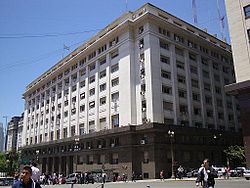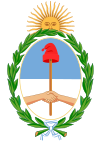Ministry of Transport (Argentina)
| Ministerio de Transporte | |
 | |
 Headquarters of the Ministry of Transport | |
| Ministry overview | |
|---|---|
| Formed | 1949 (first creation) |
| Jurisdiction | Argentina |
| Headquarters | Palacio de Hacienda, Hipólito Yrigoyen 250, Buenos Aires |
| Annual budget | $ 97,797,000 (2018)[1] |
| Minister responsible | |
| Parent department | Government of Argentina |
| Website | argentina.gob.ar/transporte |
 |
|---|
|
The Ministry of Transport (Spanish: Ministerio de Transporte) of Argentina is a ministry of the national executive power that manages issues pertaining to land, air and sea transportation within the country's limits.
First founded in 1949, the Ministry was most recently split off from the Ministry of the Interior and Transport in 2015. The position of minister has been vacant since 23 April 2021, when Mario Meoni was killed in a car accident.
History[]
The first Ministry of Transport was formed in 1949 during the presidency of Juan Domingo Perón. The first minister responsible was army colonel Juan Francisco Castro, who was in office until 1952.[2] The military governments of Eduardo Lonardi and Pedro Eugenio Aramburu retained the ministry in their cabinets,[3] but in 1958 the government of Arturo Frondizi downgraded the ministry to a secretariat, which in the following years went on to depend on various ministries, chiefly that of Public Works.[4]
In 2012, during the presidency of Cristina Fernández de Kirchner, the Ministry of the Interior was renamed as Ministry of the Interior and Transport, as the secretariat was moved to the Interior Ministry and regained ministerial status, albeit jointly with the Interior portfolio.[5] The presidency of Mauricio Macri saw the Transport portfolio upgraded to ministerial status once again; the first minister responsible this time was Guillermo Dietrich.[6]
Structure and dependencies[]
The Ministry of Transport counts with a number of centralized and decentralized dependencies. The centralized dependencies, as in other government ministers, are known as secretariats (secretarías) and undersecretariats (subsecretarías):[7][8]
- Secretariat of Transport Management (Secretaría de Gestión de Transporte)
- Undersecretariat of Rail Transport (Subsecretaría de Transporte Ferroviario)
- Undersecretariat of Automotive Transport (Subsecretaría de Transporte Automotor)
- Undersecretariat of Ports, Waterways and Merchant Navy (Subsecretaría de Puertos, Vías Navegables y Marina Mercante)
- Secretariat of Transport Planning (Secretaría de Planificación de Transporte)
- Undersecretariat of Transport Planning and Coordination (Subsecretaría de Planificación y Coordinación de Transporte)
- Secretariat of Interjurisdictional Articulation (Secretaría de Articulación Interjurisdiccional)
- Undersecretariat of Transport Economic and Financial Policy (Subsecretaría de Política Económica y Financiera de Transporte)
- Undersecretariat of Strategic Projects and Technologic Development (Subsecretaría de Proyectos Estratégicos y Desarrollo Tecnológico)
Several decentralized agencies also report to the Ministry of Transport, such as the National Road Safety Agency (ANSV), the National Transport Regulation Commission (CNRT), the Transport Safety Board, the National Civil Aviation Administration (ANAC), the Civil Aviation Accident Investigation Board, the National Airports System Regulatory Body (ORSNA), the Argentine National Transport Institute, and the General Ports Administration (AGP).[9][10][11] Several state-owned enterprises are also overseen by the Ministry of Transport, such as Argentina's flag carrier Aerolíneas Argentinas, Operadora Ferroviaria S.E., Ferrocarriles Argentinos, ADIFSE, and Trenes Argentinos Cargas.
Headquarters[]
The Ministry of Transport is headquartered in the Palacio de Hacienda ("Palace of the Treasury"), located in the Monserrat barrio in Buenos Aires, which has historically housed the Ministry of Economy (formerly known as the Ministry of the Treasury) as well as other ministerial portfolios such as public works and production.[12] The building was built in two stages from 1937 to 1950 and stands on Hipólito Yrigoyen street, across from the emblematic Plaza de Mayo square and the Casa Rosada, seat of the Presidency.[13]
List of ministers[]
| No. | Minister | Party | Term | President | ||
|---|---|---|---|---|---|---|
| Ministry of Transport (1949–1958) | ||||||
| 1 | Juan Francisco Castro | Peronist Party | 11 March 1949 – 4 June 1952 | Juan Domingo Perón | ||
| 2 | Juan Eugenio Maggi | Peronist Party | 4 June 1952 – 29 June 1955 | |||
| 3 | Alberto Iturbe | Peronist Party | 30 June 1955 – 21 September 1955 | |||
| 4 | Juan José Uranga | Independent (Military) | 23 September 1955 – 13 November 1955 | Eduardo Lonardi | ||
| 5 | Sadi Bonnet | Independent (Military) | 13 November 1955 – 1 May 1958 | Pedro Eugenio Aramburu | ||
| Ministry of the Interior and Transport (2012–2015) | ||||||
| 6 | Florencio Randazzo | Justicialist Party | 6 June 2012 – 10 December 2015 | Cristina Fernández de Kirchner | ||
| Ministry of Transport (2015–present) | ||||||
| 7 | Guillermo Dietrich | Republican Proposal | 10 December 2015 – 10 December 2019 | Mauricio Macri | ||
| 8 | Mario Meoni | Renewal Front | 10 December 2019 – 23 April 2021 | Alberto Fernández | ||
| 9 | Alexis Guerrera | Renewal Front | 3 May 2021 – incumbent | |||
References[]
- ^ "¿Qué hace el Presupuesto por vos?". Ministerio de Hacienda (in Spanish). 2017. Retrieved 30 December 2017.
- ^ Mengascini, Hugo (28 August 2008). "Conflictos y huelgas ferroviarias durante el período peronista. El caso de los trabajadores ferroviarios de Tandil (1946-1955)" (PDF). historiapolitica.com (in Spanish). Retrieved 4 May 2020.
- ^ Sáenz Quesada, María (2011). La libertadora: De Perón a Frondizi (1955-1958) Historia pública y secreta [The Libertadora: from Perón to Frondizi (1955-1958) The public and secret history] (in Spanish). Buenos Aires: Sudamericana. ISBN 9789500734172.
- ^ "LEY ORGANICA DE LOS MINISTERIOS". infoleg.gob.ar (in Spanish). 11 June 1958. Retrieved 4 May 2020.
- ^ "Una Secretaría de Transporte en nueva órbita". Página/12 (in Spanish). 7 June 2012. Retrieved 4 May 2020.
- ^ "Guillermo Dietrich, ministro de Transporte". La Nación (in Spanish). 25 November 2015. Retrieved 4 May 2020.
- ^ "Ministerio de Transporte". argentina.gob.ar (in Spanish). Retrieved 29 April 2020.
- ^ "Ministerio de Transporte". jefatura.gob.ar (in Spanish). Retrieved 4 May 2020.
- ^ "Disposición 135/2020". Boletín Oficial de la República Argentina (in Spanish). 1 April 2020. Retrieved 5 May 2020.
- ^ "Organismo Regulador del Sistema Nacional de Aeropuertos (ORSNA)". bnamericas.com. Retrieved 5 May 2020.
- ^ "SON 100 VUELOS ESPECIALES AUTORIZADOS POR EL MINISTERIO DE TRANSPORTE Y ANAC PARA EL REGRESO DE ARGENTINOS. VIDEO". aviacionenargentina.com.ar (in Spanish). 20 March 2020. Retrieved 5 May 2020.
- ^ "El Palacio de Hacienda fue declarado Monumento Histórico". nueva-ciudad.com.ar (in Spanish). 28 December 2018. Retrieved 1 May 2020.
- ^ Mejía, Virginia (28 December 2018). "Monumento histórico: el Palacio de Hacienda, mucho más que una sede ministerial". La Nación (in Spanish). Retrieved 1 May 2020.
External links[]
- Government ministries of Argentina
- Transport ministries
- Ministries established in 1949
- 1949 establishments in Argentina
